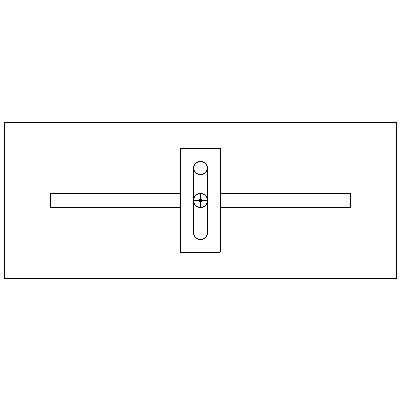
Scotch yoke
Encyclopedia


Piston
A piston is a component of reciprocating engines, reciprocating pumps, gas compressors and pneumatic cylinders, among other similar mechanisms. It is the moving component that is contained by a cylinder and is made gas-tight by piston rings. In an engine, its purpose is to transfer force from...
or other reciprocating part is directly coupled to a sliding yoke
Yoke
A yoke is a wooden beam, normally used between a pair of oxen or other animals to enable them to pull together on a load when working in pairs, as oxen usually do; some yokes are fitted to individual animals. There are several types of yoke, used in different cultures, and for different types of oxen...
with a slot that engages a pin on the rotating part. The shape of the motion of the piston is a pure sine
Sine
In mathematics, the sine function is a function of an angle. In a right triangle, sine gives the ratio of the length of the side opposite to an angle to the length of the hypotenuse.Sine is usually listed first amongst the trigonometric functions....
wave over time given a constant rotational speed
Rotational speed
Rotational speed tells how many complete rotations there are per time unit. It is therefore a cyclic frequency, measured in hertz in the SI System...
.
Advantages
The advantages compared to a standard crankshaftCrankshaft
The crankshaft, sometimes casually abbreviated to crank, is the part of an engine which translates reciprocating linear piston motion into rotation...
and connecting rod
Connecting rod
In a reciprocating piston engine, the connecting rod or conrod connects the piston to the crank or crankshaft. Together with the crank, they form a simple mechanism that converts linear motion into rotating motion....
setup are:
- Fewer moving parts.
- Smoother operation.
- Higher percentage of the time spent at top dead center (dwell) improving theoretical engine efficiency of constant volume combustion cycles, though actual gains have not been demonstrated.
- In an engine application, elimination of joint typically served by a wrist pin, and near elimination of piston skirt and cylinder scuffing, as side loading of piston due to sine of connecting rod angle is eliminated.
Disadvantages
The disadvantages are:- Rapid wear of the slot in the yoke caused by sliding friction and high contact pressures.
- Increased heat loss during combustion due to extended dwell at top dead center offsets any constant volume combustion improvements in real engines.
- Lesser percentage of the time spent at bottom dead center reducing blowdown time for two stroke engines, when compared with a conventional piston and crankshaft mechanism.
Applications
This setup is most commonly used in control valve actuatorActuator
An actuator is a type of motor for moving or controlling a mechanism or system. It is operated by a source of energy, usually in the form of an electric current, hydraulic fluid pressure or pneumatic pressure, and converts that energy into some kind of motion. An actuator is the mechanism by which...
s in high pressure oil and gas pipelines.
Although not a common metalworking machine nowadays, a Shaper
Shaper
A shaper is a type of machine tool that uses linear relative motion between the workpiece and a single-point cutting tool to machine a linear toolpath. Its cut is analogous to that of a lathe, except that it is linear instead of helical...
uses a Scotch yoke which has been adjusted to provide a slow speed forward stroke and a faster return.
It has been used in various internal combustion engines, such as the Bourke engine
Bourke engine
The Bourke Engine was designed by Russell Bourke in the 1920s, as an improved two-stroke engine. Despite finishing his design and building several working engines, the onset of World War II, lack of test results, and the poor health of his wife compounded to prevent his engine from ever coming...
, SyTech engine, and many hot air engine
Hot air engine
A hot air engine is any heat engine which uses the expansion and contraction of air under the influence of a temperature change to convert thermal energy into mechanical work...
s and steam engine
Steam engine
A steam engine is a heat engine that performs mechanical work using steam as its working fluid.Steam engines are external combustion engines, where the working fluid is separate from the combustion products. Non-combustion heat sources such as solar power, nuclear power or geothermal energy may be...
s.
Experiments have shown that extended dwell time will not work well with constant volume combustion (Otto, Bourke or similar) cycles. Gains might be more apparent using a stratified direct injection (diesel or similar) cycle to reduce heat losses.
External links
- Brock Institute for Advanced Studies: Scotch Yoke
- "Comparing Simple Crank/Slider and Scotch Yoke Mechanisms" by Fred Klingener, The Wolfram Demonstrations Project; Active demo.
- Another demo http://wiki.tcl.tk/20841 with TclTclTcl is a scripting language created by John Ousterhout. Originally "born out of frustration", according to the author, with programmers devising their own languages intended to be embedded into applications, Tcl gained acceptance on its own...
scripting language - hydrodynamic lubrication of scotch yoke mechanism http://www.delixia.com
- Animation showing working of scotch yoke mechanism used in valve actuators http://www.gas-over-oil-actuator.com/blog/scotch-yokemechanism by Vivek Thakar

